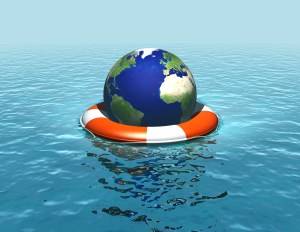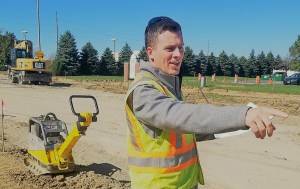Our world is constantly changing, often so slowly, we never notice. Some of this change can be attributed to natural cycles — some to the impact humans have on our environment. With increasing populations and development, we emit significantly more greenhouse gases than a century ago, which contributes to the continual warming of our planet. These gases create a greenhouse effect that traps heat in our atmosphere. This warming changes our climate and environment, and we see its impacts in melting ice caps, which raises our sea levels and increases the frequency and intensity of extreme weather events.
 Planners and engineers are examining how to make U.S. cities and infrastructure more resilient in the wake of natural disasters, such as the category 4 Hurricane Florence on the Atlantic coast in 2018.
Planners and engineers are examining how to make U.S. cities and infrastructure more resilient in the wake of natural disasters, such as the category 4 Hurricane Florence on the Atlantic coast in 2018.
Because much of our population and infrastructure is near the coasts or inland waterways, these more common and intense weather events pose a major threat to our population and infrastructure. Many recent extreme weather events, such as hurricanes Harvey, Lane, Sandy and, most recently, Florence and Michael, highlight the issues we face and prompt more discussion about how we must make our cities and infrastructure more resilient. Resiliency is the ability of a system to return to its original state after being disturbed. Our cities and infrastructure have been demolished by recent storms, and we need to plan and design cities and infrastructure to quickly recover from these events without the financial burden of constantly rebuilding or repairing after these storms occur.
So, what can we do to make our cities and infrastructure more resilient? There isn’t one solution, but a combination of factors that can reduce our risk and susceptibility to large weather events. The first steps we need to take start with a discussion, so we can recognize the issues and weigh the implementation costs, allowing us to plan and design for these events within the budgets available. We have to focus on planning for these events and determine what risks we are willing to tolerate to solve the issues our communities face and the cost to do so.
For these efforts to be successful and to recognize the benefits, there must be a diverse group of stakeholders, such as public officials, politicians, engineers, architects, landscape architects and community representatives. Without support from the stakeholders and the community, we will never be able to make the difficult decisions and implement the changes required to make our infrastructure and communities more resilient.
Reintroducing green space in our communities
I recently attended a variety of workshops and conferences that focused on starting with solutions that reintroduce nature into communities where it has been lost as populations expanded and developments occurred. Reintroducing green space next to waterways or coasts can protect from floods and storm surges. Much of the infrastructure that is supposed to protect these areas from extreme weather is deteriorating and was not designed to handle these types of major events. The existing infrastructure also tends to be unsightly and outdated, solid structures, such as sea walls and concrete-lined channels.

We need to look at what other countries have done and look for ways to redesign these areas to remove the solid barriers and convert the adjacent areas into softer, greener places which can provide more flood protection and add value and desirable spaces to our communities. There is still a need for solid structures, and as has been done in other countries, these structures can be incorporated into these green areas. However, they should be used only when required and designed to blend into the proposed spaces. These natural areas create buffers that mimic the environment that existed before communities were developed. These types of improvements are already being used in New York and New Orleans in response to hurricanes Sandy and Katrina.
As engineers and planners, we must think about the standards we use to design our infrastructure. There is a difference between “designing to code” and “good design.” Should we use the minimum standards? The minimum standards may entail the least construction cost, but what happens when a larger weather event occurs? Would this infrastructure withstand it? If it has to be rebuilt, what would that cost be and how much time would it take? What if we designed for a larger weather event? These questions must be asked, and discussions must happen to address these issues and create resilient infrastructure and communities that are livable and sustainable. If we want a sustainable world, we cannot fail to invest in our future or ignore the past.

Bryce Beckstrom, P.E., LEED AP®, is a transportation and drainage engineer at Hanson. Contact him at bbeckstrom@hanson-inc.com.